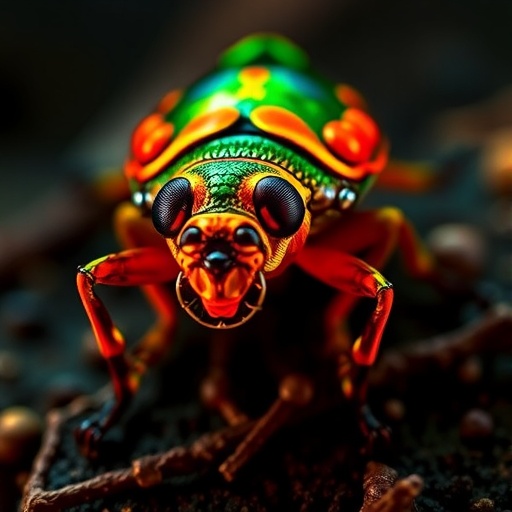In a remarkable study published in Front Zool, researchers Pavlović, Salatić, Ćurčić, and their team have unveiled a fascinating relationship between the microfluidic behavior and optical properties of the unique Hoplia beetles. This research not only illuminates the interplay between physical properties in these extraordinary insects but also opens new avenues in biomimicry for microfluidic applications and optical technologies. The study, set against the backdrop of existing literature, explores mechanisms that may have significant implications for the fields of both biology and engineering, instigating a deeper understanding of nature’s own designs.
The Hoplia beetles, renowned for their striking appearances and intricate behaviors, were the focal point of this groundbreaking investigation. A notable aspect of these beetles is their ability to manipulate light and fluid at microscopic scales, which has piqued the interest of scientists and engineers alike. The research extends existing theories on light manipulation in biological entities, examining how these beetles utilize their anatomical features to achieve such fascinating effects.
The integration of microfluidic systems and optical functionalities in living organisms is not merely a theoretical concept; it has practical implications that could bridge various scientific disciplines. For instance, understanding how Hoplia beetles manage to control light through their bodies could inspire new designs in optical devices that use minimal energy for maximum effect. Simultaneously, the microfluidic behavior observed in these creatures presents a model for creating efficient, bio-inspired fluid handling systems.
One striking outcome of the research is the modulation of light through the structurally sophisticated layers present in the chitin of the beetles’ shells. These layers, paired with specialized fluid channels, create a natural microfluidic system that aids both in enhancing visibility to predators and in attracting mates through complex signaling mechanisms. The beetles’ ability to refract and reflect light highlights an inherent efficiency that researchers are keen to replicate in artificial systems.
Researchers used advanced imaging techniques to explore the beetle’s body, detailing how its micro-architectural features contribute to its optical performance. By employing electron microscopy and spectrophotometry, the intricate textures and compositions that aid in light manipulation were analyzed. This meticulous study spotlights how even tiny deviations in structure could significantly alter optical outcomes, leading to a wealth of knowledge applicable in engineering.
Furthermore, the research emphasizes how these biological systems are not just the result of random evolution but represent billions of years of optimization. The Hoplia beetles show an extraordinary proficiency in surviving in their environments, utilizing every aspect of their morphology. Each facet of their bodies arguably serves dual roles, not merely existing for one purpose but functioning in an interdependent manner that encapsulates the principle of efficiency in nature.
The implications of such studies extend beyond biology; they challenge and inspire the fields of engineering and material sciences. For example, the findings could influence the design of new optical devices that harness similar principles. Imagine optical filters, sensors, or even illumination systems modeled after beetle structures—the potential is vast and exciting.
In addition to potential applications in optics, the microfluidic capabilities of the Hoplia beetles present fascinating opportunities in bioengineering. Systems that incorporate fluid transport similar to that observed in these beetles may revolutionize how we design products ranging from drug delivery systems to microreactors that mimic biological processes. The efficiency with which these beetles manage fluid dynamics serves as a blueprint for the development of sustainable and effective systems.
The interdisciplinary nature of this research echoes the growing trend within the scientific community to merge insights from biology with technological advancements. This reflects a shift towards biomimicry not just as a method, but as an ethos that drives innovation. As we examine the limitless intricacies of life, we can devise solutions to human challenges through the lens of nature’s accumulated knowledge.
Moreover, the study reinforces the importance of preserving biodiversity, as many of these insights hinge on the natural world. Protecting the environments where Hoplia beetles and similar species thrive is vital; extinction could mean the loss of potential discoveries that could transform industries and improve human life.
In conclusion, the research done by Pavlović and colleagues is not merely an academic exercise but a critical examination of how nature’s designs can spark revolutionary changes in technology. The Hoplia beetles are a testament to the intricate, multifaceted roles organisms play in their ecosystems, and their functionalities provide invaluable insights for future innovations in the realms of optics and microfluidics. This study serves as a stepping stone, igniting discussions on how to further explore and harness the synergy between biology and technology.
As researchers continue to delve into the complexities of biological systems, they will undoubtedly uncover more secrets that nature has meticulously crafted over millennia. The intricate and delicate balance between adaptive evolution and functional utility in organisms like the Hoplia beetles exemplifies the boundless potential for discovery that lies in the natural world, inspiring a new generation of scientific inquiry and innovation.
In the end, this study exemplifies the idea that the greatest innovations often come from the simplest observations of nature. Just as Hoplia beetles have evolved to use their unique properties for survival, so too can we learn to innovate by observing and understanding the intricate designs woven into the fabric of life.
Subject of Research: The complex interplay between the microfluidic and optical properties of Hoplia beetles.
Article Title: Complex interplay between the microfluidic and optical properties of Hoplia sp. beetles.
Article References:
Pavlović, D., Salatić, B., Ćurčić, S. et al. Complex interplay between the microfluidic and optical properties of Hoplia sp. beetles.
Front Zool 21, 28 (2024). https://doi.org/10.1186/s12983-024-00552-0
Image Credits: AI Generated
DOI: 10.1186/s12983-024-00552-0
Keywords: Hoplia beetles, microfluidic properties, optical properties, biomimicry, sustainable systems, interdisciplinary research.




